Different Media That Artist Might Use When Creating 3 and 2 Dimensional Art
The post-obit is an initial page plan for the module. The beginning text, before the colon, is the proposed page proper noun.
- Overview: introduction
- Introduction: definitions and processes
- Sculpture and other iii-dimensional media: Sculpture & Types of sculpture and other three-dimensional media
- Methods: Methods
- Modern variations: Modern variations of iii-dimensional media
- Summary: conclusion
Contents
- one Three-Dimensional Media
- 1.one Introduction
- 1.2 Definition
- 1.three Processes
- ane.4 Sculpture
- ane.5 Types of Sculpture and Iii-dimensional Media
- i.6 Methods
- 1.7 Modern Variations of Three-Dimensional Media
- 1.8 Installation Fine art
- i.9 Operation Art
- one.10 Decorative Arts
- 1.11 Product Pattern
- one.12 Decision
Iii-Dimensional Media
Introduction
In this module we look at three-dimensional works of art, the methods artists apply to create them and the different categories they occupy. Here is the outline for this module'southward content:
- Definition
- Processes:
a. Condiment
b. Subtractive
- Types of Sculpture and other Three-Dimensional Media:
1. Freestanding
ii. Relief:
a. Bas relief
b. High relief
- Methods:
a. Carving
b. Casting
c. Modeling
d. Structure/Assemblage
- Modern Variations of Three-Dimensional Media:
a. Installation Art
b. Performance Art
Definition
3-dimensional media occupies space defined through the dimensions of height, width and depth. It includes sculpture, installation and performance art, decorative art, and product pattern.
Processes
Two processes are responsible for all three-dimensional art: additive , in which material is congenital up to create class, or subtractive , where material is removed from an existing mass, such as a chunk of rock, forest or dirt. The different categories we'll examine hither are not necessarily exclusive from each other, and we will look at some examples of 3-dimensional art that arguably cross over betwixt categories. Starting time, let's await at the unlike types of sculpture and the methods used to creating them to understand the important characteristics of each one.
Sculpture
Sculpture is any artwork fabricated by the manipulation of materials resulting in a three-dimensional object. The sculpted figure of the Venus of Berekhat Ram, discovered in the Middle Due east in 1981, dates to 230,000 years BCE. It is the oldest example of artwork known. The crudely carved stone figure will fit in the palm of your manus. Its name derives from the similarity in class with and so-called female person fertility figures plant throughout Europe, some of which date to 25,000 years ago. For instance, The class of the Venus of Willendorf beneath shows remarkable skill in its etching, including artillery draped over exaggerated breasts, an extended abdomen and elaborate patterning on the head, indicating either a braided hairstyle or type of woven cap. Just as remarkable, the figure has no facial particular to indicate identity. The meaning backside these figures is hard to put into context because of the lack of any written tape about them or other supporting materials.
Venus of Willendorf, c. 25,000 BCE. Natural History Museum, Vienna. This paradigm is licensed under the Creative Commons Attribution-Share Akin three.0 Unported license.
![]()
These primeval images are indicative of near of the cultural record in sculpture for thousands of years; singular figurative objects fabricated within an iconographic context of myth, ritual or ceremony. It'south not until the Onetime Kingdom period of Egyptian sculpture, between 3100 and 2180 BCE, that we start to run into sculpture that reflects a resemblance of specific figures.
Types of Sculpture and Three-dimensional Media
Sculpture tin can be freestanding , or self-supported, where the viewer can walk completely around the work to encounter it from all sides, or created in relief, where the primary form'south surface is raised to a higher place the surrounding material, such as the image on a money. Bas-relief refers to a shallow extension of the prototype from its surroundings, high relief is where the almost prominent elements of the composition are undercut and rendered at more than half in the circular against the background. Rich, animated bas-relief sculpture exists at the Banteay Srei temple near Angor Wat, Cambodia. Hither humans and mythic figures combine in depictions from ancient Hindu stories.
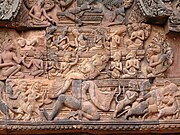
![]()
Bas-relief sculpture at the temple Banteay Srei, Angor, Cambodia. 10th century. Sandstone. This image is licensed under the Creative Eatables Attribution 2.v Generic license.
The Shaw Memorial combines freestanding, bas and loftier relief elements in ane masterful sculpture. The work memorializes Colonel Robert Gould Shaw and the Massachusetts 50 fourth regiment, the first African-American infantry unit to fight for the north in the civil state of war.
Methods
1. Etching uses the subtractive process to cut away areas from a larger mass, and is the oldest method used for three-dimensional work. Traditionally rock and wood were the most common materials because they were readily bachelor and extremely durable. Contemporary materials include foam, plastics and drinking glass. Using chisels and other sharp tools, artists carve away material until the ultimate form of the work is accomplished.
A beautiful example of the carving process is seen in the Water and Moon Bodhisattva from 10th century Prc. The Bodhisattva, a Buddhist figure who has attained Enlightenment only decides to stay on earth to teach others, is exquisitely carved and painted. The figure is nearly eight feet high, seated in an elegant pose on a lotus bloom, relaxed, staring directly ahead with a calm, benevolent look. The extended right arm and raised knee create a stable triangular composition. The sculptor carves the left arm to simulate muscle tension inherent when information technology supports the weight of the torso.
In another case, yous tin can see the high degree of relief carved from an original wood cake in this mask from the Pacific Northwest Declension Kwakwaka' wakw culture. The mask was used in winter ceremonies where animals were said to take human grade. It's extraordinary for masks to personify a natural issue. This and other mythic figure masks are used in ritual and ceremony dances. The broad areas of paint give a heightened sense of grapheme to this mask.
Forest sculptures by contemporary artist Ursula von Rydingsvard are carved, glued and even burned. Many are massive, rough vessel forms that conduct the visual prove of their creation.
Michelangelo'south masterpiece Statue of David from 1501 is carved and sanded to an idealized course that the artist releases from the massive block, a testament to human aesthetic brilliance.
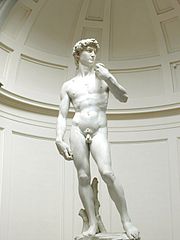
![]()
Michelangelo, David, 1501, marble, 17' high. Galleria dell'Accademia, Florence. This image is licensed under the Creative Commons Attribution-Share Akin three.0 Unported license.
2. Casting: The additive method of casting has been in use for over 5 chiliad years. Information technology'southward a manufacturing process by which a liquid material is usually poured into a mold, which contains a hollow cavity of the desired shape, and then allowed to solidify. 1 traditional method of bronze casting often used today is the lost wax procedure. Casting materials are usually metals but can be diverse cold setting materials that cure afterwards mixing 2 or more than components together; examples are epoxy, concrete, plaster and clay. Casting is most frequently used for making complex shapes that would be otherwise difficult or uneconomical to make by other methods. It's a labor-intensive process that allows for the creation of multiples from an original object (similar to the medium of printmaking), each of which is extremely durable and exactly like its predecessor. A mold is usually destroyed subsequently the desired number of castings has been made. Traditionally, bronze statues were placed atop pedestals to signify the importance of the effigy depicted. A statue of William Seward (below), the U. South. Secretary of State under Abraham Lincoln and who negotiated the purchase of the Alaska territories, is set nearly eight feet high then viewers must look upward at him. Standing next to the globe, he holds a roll of plans in his left hand.
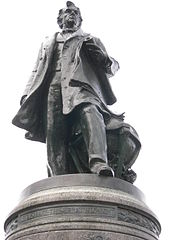
![]()
Richard Brooks, William Seward, bronze on stone pedestal, c. 1909. This prototype is licensed under the Artistic Commons Attribution-Share Alike three.0 Unported license and attributed to Joe Mabel.
More contemporary statuary cast sculptures reflect their subjects through different cultural perspectives. The statue of rock guitarist Jimi Hendrix is set on the basis, his effigy cast as if performing on stage. He's on both of his knees, caput thrown dorsum, eyes shut and rima oris open in mid wail. His bell-bottom pants, frilly shirt unbuttoned halfway, necklace and headband give us a snapshot of 1960's rock culture but besides engage us with the field of study at our level.
three. Modeling is a method that can be both additive and subtractive. The artist uses modeling to build up form with dirt, plaster or other soft cloth that tin be pushed, pulled, pinched or poured into identify. The material then hardens into the finished work. Larger sculptures created with this method make use of an armature , an underlying structure of wire that sets the physical shape of the work. Although modeling is primarily an additive process, artists do remove material in the process. Modeling a form is ofttimes a preliminary footstep in the casting method. In 2010, Swiss artist Alberto Giacometti's Walking Man (c. 1955), a bronze sculpture start modeled in clay, set a tape for the highest price always paid for a work of art at auction.
4. Construction, or Assemblage , uses found, manufactured or altered objects to build class. Artists weld, mucilage, bolt and wire individual pieces together. Sculptor Debra Butterfield transforms throw away objects into abstruse sculptures of horses with scrap metal, wood and other plant objects. She often casts these constructions in statuary.
Louise Nevelson used cut and shaped pieces of woods, gluing and nailing them together to form fantastic, complex compositions. Painted a single tone, (commonly black or white), her sculptures are graphic, textural facades of shapes, patterns and shadow.
Traditional African masks frequently combine different materials. The elaborate Kanaga Mask from Republic of mali uses forest, fibers, fauna hide and paint to construct an other worldly visage that changes from human being to beast and back again.
Some modern and contemporary sculptures contain movement, light and sound. Kinetic sculptures use ambient air currents or motors assuasive them to motility, irresolute in form as the viewer stands in identify. The artist Alexander Calder is famous for his mobiles, whimsical, abstract works that are intricately balanced to movement at the slightest wisp of air, while the sculptures of Jean Tinguely are contraption-similar and, like to Nevelson'due south and Butterfield's works, synthetic of scraps often found in garbage dumps. His motorized works exhibit a mechanical aesthetic equally they whir, rock and generate noises. Tinguely's well-nigh famous work, Homage to New York, ran in the sculpture garden at New York'due south Museum of Modern Art in 1960 as part of a performance by the creative person. After several minutes, the work exploded and defenseless fire.
The idea of generating audio as part of three-dimensional works has been utilized for hundreds of years, traditionally in musical instruments that conduct a spiritual reference. Contemporary artists utilize sound to heighten the consequence of sculpture or to direct recorded narratives. The bandage statuary fountain by George Tsutakawa uses water flow to produce a soft rushing audio. In this instance the sculpture also attracts the viewer by the motility of the h2o: a clear, fluid addition to an otherwise hard abstract surface.
Doug Hollis' A Sound Garden from 1982 creates sounds from hollow metallic tubes atop filigree like structures rising above the ground. In weather vane fashion, the tubes swing into the wind and resonate to specific pitch. The audio extends the artful value of the piece of work to include the sense of hearing and, together with the metal construction, creates a mechanical and psychological ground for the work.
Mod Variations of Three-Dimensional Media
Flavin is one of the start artists to explore the possibilities of lite equally a sculptural medium. Since the 1960's his work has incorporated fluorescent bulbs of unlike colors and in various arrangements. Moreover, he takes advantage of the wall space the light is projected onto, literally blurring the line between traditional sculpture and the more circuitous medium of installation.uorescent bulbs of different colors and in various arrangements. Moreover, he takes advantage of the wall infinite the light is projected onto, literally blurring the line between traditional sculpture and the more complex medium of installation .
Installation Art
Installation art utilizes multiple objects, ofttimes from various mediums, and takes up entire spaces. It can exist generic or site specific. Because of their relative complexity, installations can accost aesthetic and narrative ideas on a larger scale than traditional sculpture. Its genesis can be traced to the Dada movement, ascendant afterward World War I and which predicated a new artful by its unconventional nature and ridicule of established tastes and styles. Sculpture came off the pedestal and began to transform entire rooms into works or fine art. Kurt Schwitters' Merzbau, begun in 1923, transforms his apartment into an abstract, claustrophobic space that is at in one case role sculpture and compages. With installation fine art the viewer is surrounded by and tin can go part of the piece of work itself.
British creative person Rachel Whiteread's installation Embankment from 2005 fills an unabridged exhibition hall with casts made from various sized boxes. At first appearance a snowy mount landscape navigated past the viewer is really a gigantic nod to the thought of boxes as receptacles of memory towering above and stacked around them, squeezing them towards the center of the room.
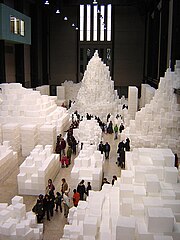
![]()
Rachel Whiteread, Beach, 2005. This image is licensed under the Creative Eatables Attribution-Share Alike 2.5 Generic license.
Ilya Kabakov mixes together a narrative of political propaganda, sense of humour and mundane existence in his installation The Homo Who Flew Into Infinite From His Apartment from 1984. What we see is the remains of a small apartment plastered with Soviet era posters, a small bed and the makeshift slingshot a man uses to escape the drudgery of his life within the system. A gaping hole in the roof and his shoes on the floor are evidence enough that he made it into infinite.
Performance Art
Performance art goes a step further, involving the creative person as office of the work itself. Some operation artworks are interactive, involving the viewer besides. The nature of the medium is in its ability to utilize live performance in the same context as static works of art: to enhance our understanding of creative experience. Similar to installation works, functioning fine art had its start manifestations during the Dada art movement, when alive performances included poesy, visual art and music, frequently going on at the same time.
The German creative person Joseph Beuys was instrumental in introducing performance art as a legitimate medium in the post Earth War Two artistic milieu. I Like America and America Likes Me from 1974 finds Beuys co-existing with a coyote for a week in the Rene Cake Gallery in New York Metropolis. The artist is protected from the creature by a felt blanket and a shepherd's staff. Operation fine art, similar installation, challenges the viewer to reexamine the artistic feel from a new level.
In the 1960's Allen Kaprow's Happenings invited viewers to be the participants. These events, sometimes rehearsed and other times improvised brainstorm to erase the line between the artist and the audience. Yoko Ono's Cut Slice from 1965 specifically invites members of the audience to collaborate with her on phase.
This same idea – using the artist'due south body equally subject, is axiomatic in the functioning art of Marina Abramovic. In The Artist is Present she sits quietly as private visitors sit across the table from her, exchanging silent glances and stares.
Today nosotros come across a new form of operation art happen unexpectedly around u.s.a. in the class of Flash Mobs : groups of people who gather in public spaces to collaborate in short, seemingly spontaneous events that entertain and surprise passersby. Many flash mobs are arranged in advance through the use of social media. An example of wink mob performance is Practice Re Mi in the Central Station in Antwerp, Belgium in March of 2009.
Decorative Arts
Decorative fine art requires the specific skilled use of tools in creating works or art. These tools can accept many forms: words, construction tools, a photographic camera, a paintbrush or even a vocalisation. Traditional studio arts include ceramics, metal and woodworking, weaving and the glass arts. Decorative arts are distinguished by a high degree of workmanship and finish. They have their roots in commonsensical purposes: article of furniture, utensils and other everyday accoutrements that are designed for specific uses, and reflect the adage that "form follows function". But human creativity goes beyond elementary role to include the artful realm, entered through the doors of embellishment, decoration and an intuitive sense of blueprint.
In the first case below, the smooth simple lines of a Tulip Chair, were designed by Eero Saarinen as an exercise in clarifying form. When information technology was made its futuristic use of curved lines and artificial materials were seen as emblematic of the "infinite age." In some other example, a staircase crafted in the Shaker fashion takes on an elegant form that mirrors the organic spiral shape representing the 'gilded ratio' we explored in module 4.
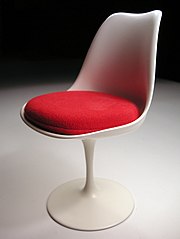
![]()
Saarinen Tulpanstolen. This epitome is licensed nether the Creative Commons Attribution-Share Alike iii.0 Unported license.
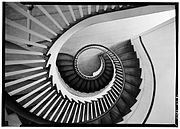
![]()
Shaker style staircase, Pleasant Hill, Kentucky. Photo by Jack Boucher, National Parks Service. This paradigm is in the public domain.
Utility is not the sole purpose of decorative arts. The Persian carpet beneath has its use as a commonsensical object, just the craftsmanship shown in its blueprint and design gives it a separate aesthetic value. The decorative chemical element is visually stimulating, every bit if the artisan uses the rug every bit simply a vehicle for his or her ain artistic imagination.
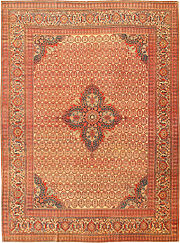
![]()
Antique Tabriz Farsi carpet. This prototype is licensed nether the Artistic Commons Attribution-Share Alike 3.0 Unported license.
As we've seen in an earlier module, quilts made in the rural customs of Gee's Curve Alabama testify a diverse range of individual patterns within a larger pattern structure of colorful stripes and blocks, and have a ground in graphic textile designs from Africa.
Even a small tobacco bag from the Native American Sioux culture (below) becomes a piece of work of art with its intricate beaded patterns and floral designs.

![]()
Sioux quilled tobacco pocketbook. This image is in the public domain.
The craftsmanship in glass making is ane of the well-nigh demanding. Working with an extremely frail medium presents unique challenges. Challenges bated, the delicate nature of glass gives information technology exceptional visual presence. A blown glass urn dated to first century Rome is an example. The fact that it has survived the ages intact is testament to its ultimate strength and beauty.
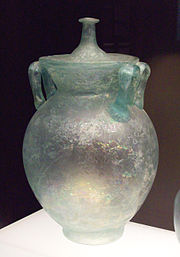
![]()
Cinerary Urn, Roman. C. 1st century CE. Blown glass. National Archaeological Museum, Spain. Luis Garcia Zaqarbal. This prototype is licensed under the Creative Eatables Attribution-Share Alike 3.0 Unported, 2.5 Generic, 2.0 Generic and 1.0 Generic license.
Louis Comfort Tiffany introduced many styles of decorative glass between the late 19th and beginning role of the 20th centuries. His stained drinking glass window The Holy Metropolis in Baltimore Maryland has intricate details in illustrations influenced by the Art Nouveau style pop at the turn of the 19th century.

![]()
Louis Comfort Tiffany, The Holy City, stained glass window, Brown Memorial Presbyterian Church building, Baltimore, Maryland. 1905. This image is attributed to James G. Howes
The artist Dale Chihuly has redefined the traditional arts and crafts of drinking glass making over the final xl years, moving it towards the mainstream of art with single objects and big scale installations involving hundreds of individual pieces.
Product Design
The dictum "form follows function" represents an organic arroyo to 3-dimensional design. The products and devices we utilise everyday continue to serve the same functions but change in styles. This constant realignment in bones class reflects mod aesthetic considerations and, on a larger scale, become artifacts of the popular culture of a given fourth dimension period.
The two examples below illustrate this idea. Like Tiffany glass, the chair designed by Henry van de Velde in 1895 reflects the Fine art Nouveau style in its wood construction with organic, stylized lines and curvilinear form. In comparison, the Pismire Chair from 1952 retains the bones functional form with more modern design using a triangular leg configuration of tubular steel and a single piece of laminated woods veneer, the cut out shape suggesting the form of a black ant.
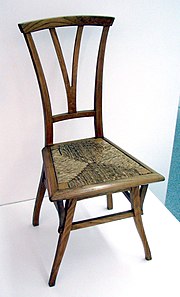
![]()
Henry van de Velde, Chair, 1895. Woods, woven fiber. This image is licensed nether the Creative Commons Attribution-Share Alike 3.0 Unported license and attributed to Chris 73.
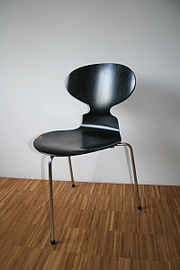
![]()
Arne Jacobsen, Ant Chair, 1952. Steel and wood. This image is licensed under the Creative Commons Attribution-Share Alike iii.0 Unported license.
Determination
Three-dimensional media includes many forms including sculpture, decorative arts, and production design. They are the oldest and most durable of all the artistic arts. Y'all can see how the dissimilar creative processes and methods generate a various range of visual forms and characteristics. Decorative art in particular has its origins in utility just is no longer exclusive to this realm, and innovations about the nature of 3-dimensional media have led to the gimmicky forms of installation and functioning art, with the inclusion at times of both the artist and the viewer into the piece of work itself. You'll experience and learn more about three-dimensional media in the learning activities that accompany this module.
Source: https://wikieducator.org/Art_Appreciation_and_Techniques/Module_5c_Three_dimensional_media
0 Response to "Different Media That Artist Might Use When Creating 3 and 2 Dimensional Art"
ارسال یک نظر